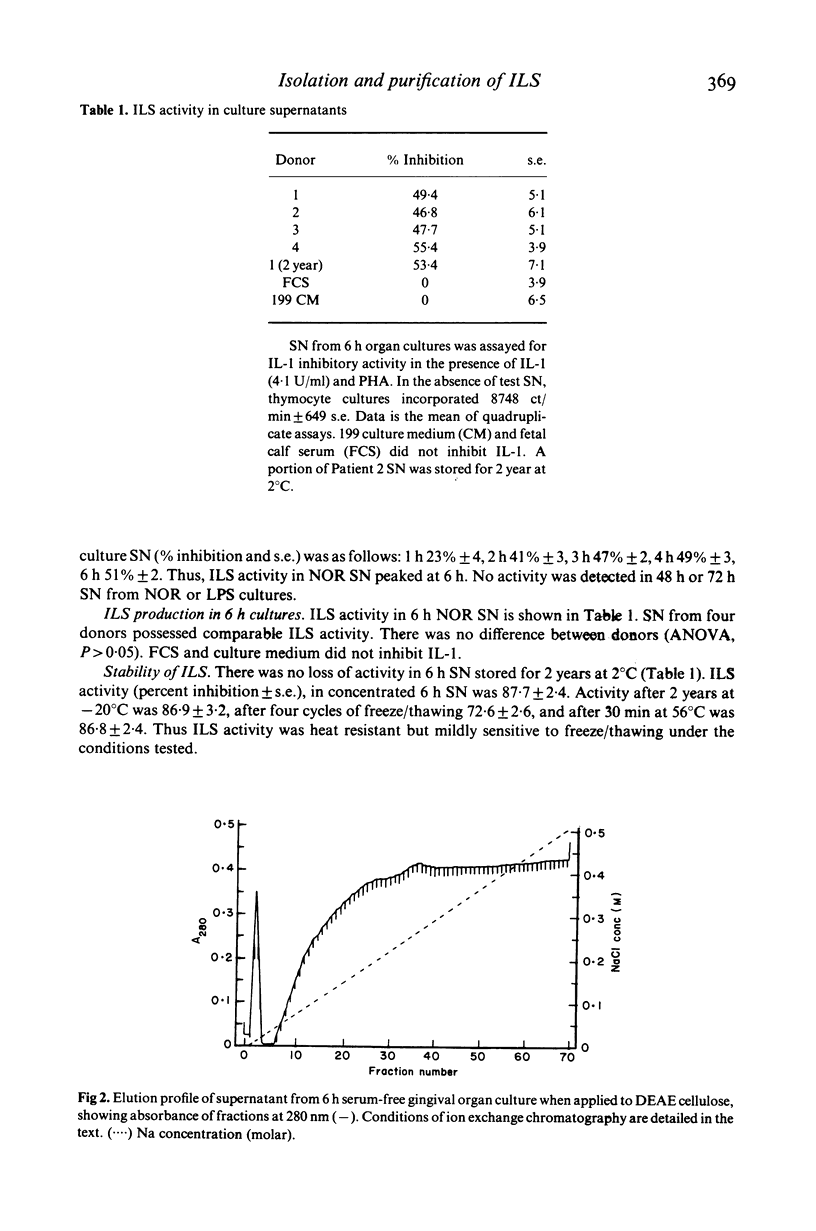Abstract
Recent studies have described the presence of an interleukin 1 (IL-1) inhibitor (ILS) in supernatants from human gingival organ cultures. This report describes the isolation and purification of ILS. ILS was produced in serum-free medium and purified to apparent homogeneity by ion exchange chromatography and high pressure liquid chromatography. IL-1 and ILS eluted as discrete proteins using this system, with ILS appearing as a single protein band of 97,400 molecular weight on SDS-PAGE. ILS inhibited the effects of both murine IL-1 and IL-2 on thymocyte proliferation, and was heat resistant, moderately resistant to freeze-thawing and stable for 2 years at 0-4 degrees C or -20 degrees C. Production of ILS by gingival epithelial cell cultures was not affected by depletion of Langerhans cells, implying that ILS is primarily a keratinocyte product.
Full text
PDF








Images in this article
Selected References
These references are in PubMed. This may not be the complete list of references from this article.
- Czernielewski J., Faure M., Schmitt D., Thivolet J. In vitro mixed skin cell lymphocyte culture reaction (MSLR) in man: analysis of the epidermal cell and T cell subpopulations. Clin Exp Immunol. 1982 Nov;50(2):426–433. [PMC free article] [PubMed] [Google Scholar]
- Farrar W. L., Johnson H. M., Farrar J. J. Regulation of the production of immune interferon and cytotoxic T lymphocytes by interleukin 2. J Immunol. 1981 Mar;126(3):1120–1125. [PubMed] [Google Scholar]
- Fujiwara H., Ellner J. J. Spontaneous production of a suppressor factor by the human macrophage-like cell line U937. I. Suppression of interleukin 1, interleukin 2, and mitogen-induced blastogenesis in mouse thymocytes. J Immunol. 1986 Jan;136(1):181–185. [PubMed] [Google Scholar]
- Hawley-Nelson P., Sullivan J. E., Kung M., Hennings H., Yuspa S. H. Optimized conditions for the growth of human epidermal cells in culture. J Invest Dermatol. 1980 Aug;75(2):176–182. doi: 10.1111/1523-1747.ep12522602. [DOI] [PubMed] [Google Scholar]
- Laemmli U. K. Cleavage of structural proteins during the assembly of the head of bacteriophage T4. Nature. 1970 Aug 15;227(5259):680–685. doi: 10.1038/227680a0. [DOI] [PubMed] [Google Scholar]
- Liao Z., Grimshaw R. S., Rosenstreich D. L. Identification of a specific interleukin 1 inhibitor in the urine of febrile patients. J Exp Med. 1984 Jan 1;159(1):126–136. doi: 10.1084/jem.159.1.126. [DOI] [PMC free article] [PubMed] [Google Scholar]
- Liao Z., Haimovitz A., Chen Y., Chan J., Rosenstreich D. L. Characterization of a human interleukin 1 inhibitor. J Immunol. 1985 Jun;134(6):3882–3886. [PubMed] [Google Scholar]
- Mizel S. B., Oppenheim J. J., Rosentreich D. L. Characterization of lymphocyte-activating factor (LAF) produced by a macrophage cell line, P388D1. II. Biochemical characterization of LAF induced by activated T cells and LPS. J Immunol. 1978 May;120(5):1504–1508. [PubMed] [Google Scholar]
- Scala G., Kuang Y. D., Hall R. E., Muchmore A. V., Oppenheim J. J. Accessory cell function of human B cells. I. Production of both interleukin 1-like activity and an interleukin 1 inhibitory factor by an EBV-transformed human B cell line. J Exp Med. 1984 Jun 1;159(6):1637–1652. doi: 10.1084/jem.159.6.1637. [DOI] [PMC free article] [PubMed] [Google Scholar]
- Tiku K., Tiku M. L., Liu S., Skosey J. L. Normal human neutrophils are a source of a specific interleukin 1 inhibitor. J Immunol. 1986 May 15;136(10):3686–3692. [PubMed] [Google Scholar]
- Walsh L. J., Powell R. N., Seymour G. J., Newcomb G. M. Loss of Langerhans cells from gingival tissue maintained in organ culture. J Oral Pathol. 1984 Dec;13(6):604–613. doi: 10.1111/j.1600-0714.1984.tb01462.x. [DOI] [PubMed] [Google Scholar]
- Walsh L. J., Seymour G. J., Bird P. S., Powell R. N. Modulation of HLA-DR antigens in the gingival epithelium in vitro by heat-killed Fusobacterium nucleatum and E. coli lipopolysaccharide. J Oral Pathol. 1985 Nov;14(10):833–843. doi: 10.1111/j.1600-0714.1985.tb00473.x. [DOI] [PubMed] [Google Scholar]
- Walsh L. J., Seymour G. J., Powell R. N. Modulation of class II (DR and DQ) antigen expression on gingival Langerhans cells in vitro by gamma interferon and prostaglandin E2. J Oral Pathol. 1986 Jul;15(6):347–351. doi: 10.1111/j.1600-0714.1986.tb00638.x. [DOI] [PubMed] [Google Scholar]
- Walsh L. J., Seymour G. J., Powell R. N. Modulation of gingival Langerhans cell T6 antigen expression in vitro by interleukin 1 and an interleukin 1 inhibitor. Clin Exp Immunol. 1986 May;64(2):334–341. [PMC free article] [PubMed] [Google Scholar]
- Walsh L. J., Seymour G. J., Powell R. N. The in vitro effect of retinol on human gingival epithelium. II. Modulation of Langerhans cell markers and interleukin-1 production. J Invest Dermatol. 1985 Dec;85(6):501–506. doi: 10.1111/1523-1747.ep12277300. [DOI] [PubMed] [Google Scholar]
- Weber K., Osborn M. The reliability of molecular weight determinations by dodecyl sulfate-polyacrylamide gel electrophoresis. J Biol Chem. 1969 Aug 25;244(16):4406–4412. [PubMed] [Google Scholar]



